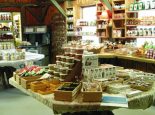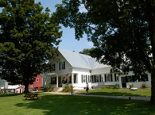Experience Family Farm Hospitality & Home Cooking at its Best!~Welcoming Inn Guests from Around the World Since 1984~
For a quarter of a century, we’ve opened our doors and hearts to guests from around the world. Many of our guests return year after year and have become dear friends. Maybe it’s because of Beth’s incredible, home-cooked meals or the novelty of a genuine, working dairy farm. Perhaps it is the allure of the peace and quiet of this stunningly beautiful corner of Vermont or the chance to milk a real cow! Some come to celebrate anniversaries, others family reunions. Whatever the reason for your visit, we are blessed to be able to share our home and our way of life with you. Are you looking for outdoor adventure or looking for a quiet retreat? Liberty Hill Farm offers the best of both. You are always welcome here! From our family to yours…
We have 7 guest bedrooms in the Inn at Liberty Hill Farm, 5 rooms with queen-size beds, 1 room with 2 single beds, and 1 room with 5 single beds. There are 4 shared bathrooms. We have plenty of common areas for everyone to enjoy. Our guests like to peruse the books and games available, as well as enjoy visiting with each other. We also feature free Wifi throughout the Inn.
A Brief History of Liberty Hill Farm
1780 – John Emerson founds Liberty Hill Farm.
1787 – John Emerson constructs the oldest part of the present barn.
1837 – Dr. Charles Wesley Emerson, founder of Emerson College Boston, Massachusetts,is born on Liberty Hill.
1884 – Dr. Emerson comes home to Vermont and reacquires his grandfather’s land in Rochester.
1888 – Dr. Emerson purchases the present day weathervane in Cambridge, MA, and brings it by train to Rochester. The last leg of the journey is on Rochester’s fabled Peavine Railway, which drops off Dr. Emerson and his new purchase directly at the farm.
1889 – The Big Red Barn is completed by Dr. Emerson.
1894 – Most of the Emerson grant land is sold, and Dr. Emerson remodels the farmhouse next door into a showcase summer house.
1908 – Dr. Emerson dies and his summer residence on Liberty Hill passes to his niece, Eleanor Jones Hutchinson.
1890-1930 – The farm is owned by the Eastman family.
1920-1950s – Kezar family own and farm the property, then known as Kezar Farm.
1960 – John and Esther Hunt move to the farm after their barn on Liberty Hill burns.
1979 – In March, Beth and Bob Kennett purchase Liberty Hill Farm from the Hunt family as a turn-key operation. John Hunt milked one night, Bob started the next morning.
1984 – Liberty Hill Farm opens its doors as a farm vacation destination. The first guests, the Kerwin Family from New Jersey, continue to return on a regular basis. Liberty Hill Farm has welcomed guests from all 50 states and from around the world, many of whom return year after year. New generations are now among the guests.
2007- Both Kennett sons decide to farm with Dad!! We need to increase the herd to provide for the whole family. The neighbors help us add onto the barn, creating the “Habitat for Bovinity”!! The cows mooove in to the new portion in January.
2008- Yankee Magazine featured Liberty Hill Farm as one of the Top 5 Places in New England!! Christina Tree, renowned travel guide, was asked “If she could stay overnight at only five places in New England, where would they be?” Liberty Hill Farm was on the list!!


